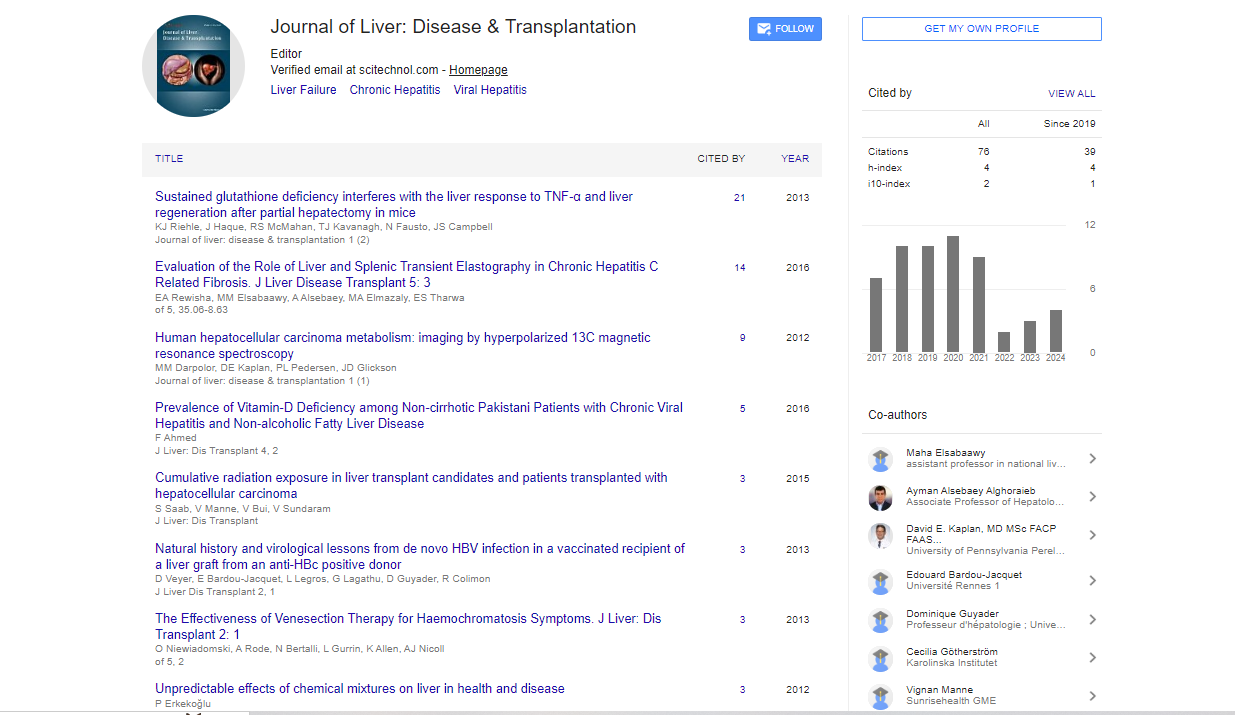Commentary, J Liver Disease Transplant Vol: 13 Issue: 4
Non-Invasive Biomarkers for Liver Fibrosis: A Review of Recent Advances and Clinical Applications
Nestor Parker*
1Department of Immunology, Complutense University, Madrid, Spain
*Corresponding Author: Nestor Parker,
Department of Immunology, Complutense
University, Madrid, Spain
E-mail: parkern@usmc.cu.es
Received date: 28 November, 2024 Manuscript No. JLDT-24-156905;
Editor assigned date: 02 December, 2024, PreQC No. JLDT-24-156905 (PQ);
Reviewed date: 16 December, 2024, QC No. JLDT-24-156905;
Revised date: 23 December, 2024, Manuscript No. JLDT-24-156905 (R);
Published date: 30 December, 2024, DOI: 10.4172/2325-9612.1000285.
Citation: Parker N (2024) Non-Invasive Biomarkers for Liver Fibrosis: A Review of Recent Advances and Clinical Applications. J Liver Disease Transplant 13:4.
Description
Liver fibrosis is a significant health concern that arises primarily from chronic liver diseases, such as hepatitis B and C infections, Non- Alcoholic Fatty Liver Disease (NAFLD) and alcohol-related liver disease. The progression of liver fibrosis can eventually lead to severe complications like cirrhosis and liver cancer. Traditionally, the diagnosis of liver fibrosis has relied on invasive methods such as liver biopsy, which, although widely accepted, presents limitations in terms of invasiveness, cost and patient discomfort. Non-invasive biomarkers have emerged as a assuring alternative to monitor liver fibrosis, offering potential advantages such as higher patient compliance, reduced healthcare costs and the ability to perform repeated assessments without the risks associated with biopsy. Recent advances in non-invasive biomarker study have led to the development of various tools that aim to estimate liver fibrosis stages accurately. These biomarkers are generally categorized into three main types: serum-based markers, imaging based techniques and combination panels. Serum-based biomarkers are among the most widely used noninvasive methods for evaluating liver fibrosis. They typically involve the measurement of specific proteins or other biochemical markers that reflect liver damage and fibrosis. One of the most notable serum biomarkers is the Fibrosis-4 (FIB-4) index, which combines age, platelet count and serum levels of Alanine Aminotransferase (ALT) and Aspartate Aminotransferase (AST). FIB-4 has proven to be a reliable predictor of advanced liver fibrosis, with high sensitivity and specificity. Other serum markers, such as the Enhanced Liver Fibrosis (ELF) score and the FibroTest, have also demonstrated clinical utility. These markers provide a composite assessment based on multiple factors, such as procollagen III peptides, hyaluronic acid and Tissue Inhibitors of Metalloproteinases (TIMPs).
Imaging-based techniques have also shown considerable assurance in assessing liver fibrosis. Ultrasound-based elastography methods, including Transient Elastography (TE) and Magnetic Resonance Elastography (MRE), have gained popularity due to their non-invasive nature and relatively high accuracy in detecting fibrosis stages. Transient elastography, for instance, measures the liver’s stiffness by assessing the speed of a shear wave as it travels through the liver tissue. Studies have validated its effectiveness, especially in patients with chronic viral hepatitis and NAFLD. Magnetic resonance elastography, although more expensive and less widely available, offers high-resolution imaging and is particularly useful for patients with obesity, where TE may have limitations. Another promising advancement is the use of combination panels, which integrate multiple biomarkers to improve the accuracy and precision of fibrosis assessment. One such panel is the FibroScan-based panels, which combine transient elastography with serum biomarkers to generate a more comprehensive risk assessment for liver fibrosis. For example, the combination of the FIB-4 index with TE provides enhanced diagnostic accuracy, reducing the need for invasive procedures. Clinical applications of these non-invasive biomarkers have shown significant benefits. They are particularly valuable for monitoring patients with chronic liver diseases who are at risk of developing fibrosis, allowing for early detection and timely intervention. Noninvasive methods are especially advantageous for large-scale population-based screening, where the accessibility and costeffectiveness of biomarkers plays an important role. Additionally, these biomarkers facilitate the ongoing monitoring of fibrosis progression or regression, reducing the reliance on repeated biopsies.
Conclusion
Non-invasive biomarkers have emerged as an important tool in the assessment and management of liver fibrosis. Advances in serumbased markers, imaging technologies and combination panels have enhanced diagnostic accuracy while reducing the risks associated with invasive procedures. These innovations have significant clinical implications, particularly in the early detection, monitoring and management of liver fibrosis, improving patient outcomes and healthcare efficiency. Further study is needed to refine these biomarkers, ensuring their optimal use in clinical practice.
 Spanish
Spanish  Chinese
Chinese  Russian
Russian  German
German  French
French  Japanese
Japanese  Portuguese
Portuguese  Hindi
Hindi 